Cell Structure and Function: Week 3 - Fluid Compartments, Dynamics
VerifiedAdded on 2023/05/02
|9
|2434
|254
Homework Assignment
AI Summary
This assignment solution covers key concepts related to cell structure and function, focusing on the three major fluid compartments of the human body: intracellular fluid, extracellular fluid, and plasma. It delves into the structure and function of the plasma membrane, explaining selective permeability and the electrochemical gradient. The document describes passive transport processes like simple diffusion, facilitated diffusion (channel-mediated and carrier-mediated), and osmosis. It further explains active transport mechanisms, including primary and secondary active transport, as well as vesicular transport processes like endocytosis, exocytosis, and transcytosis. The assignment also outlines the structure and function of intracellular compartments, including the cytoskeleton, cytoplasm, centrosome, cilia, flagella, ribosomes, endoplasmic reticulum, Golgi complex, lysosomes, peroxisomes, and proteasomes. The document concludes with a question regarding facilitated diffusion of glucose in liver cells.
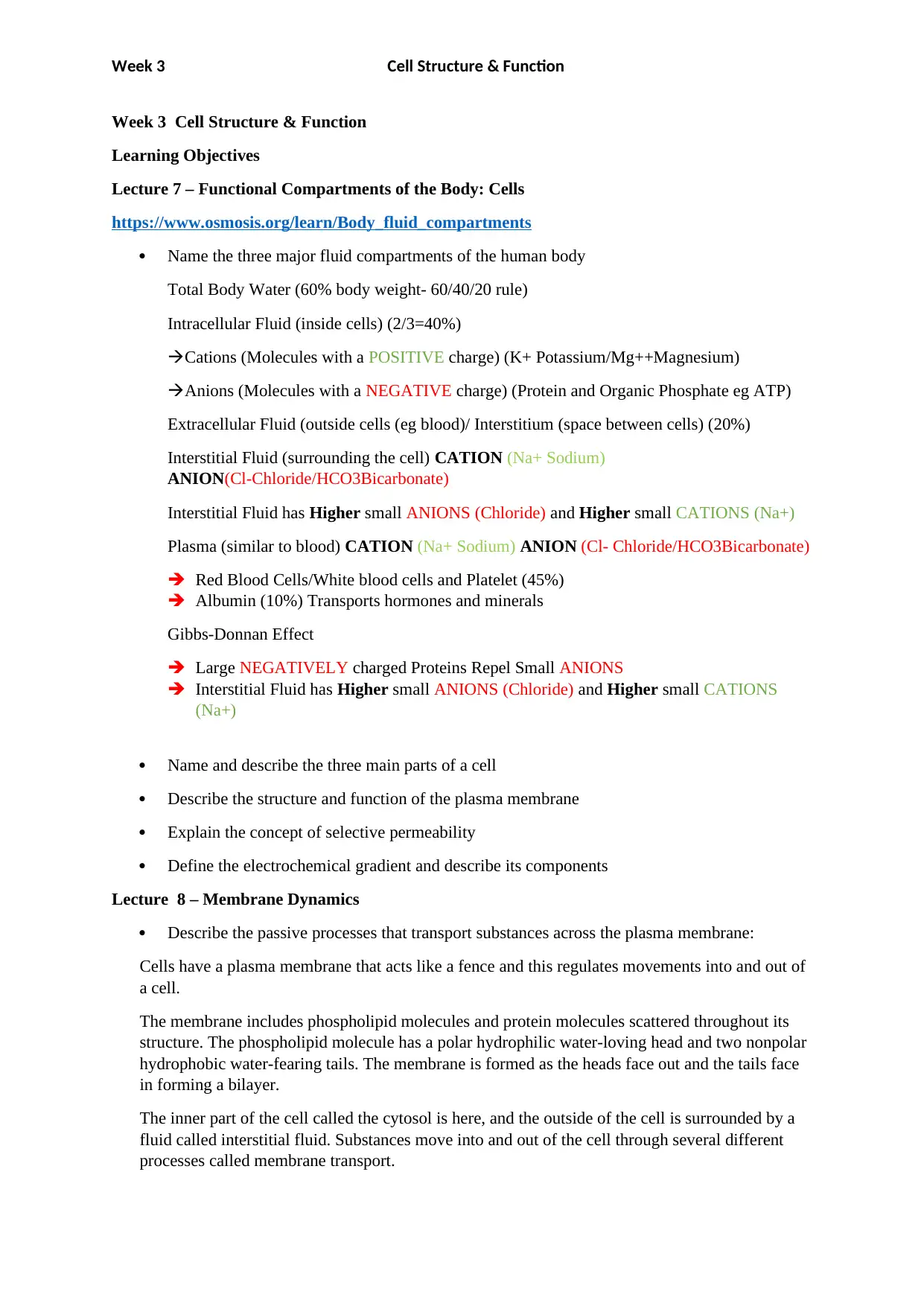
Week 3 Cell Structure & Function
Week 3 Cell Structure & Function
Learning Objectives
Lecture 7 – Functional Compartments of the Body: Cells
https://www.osmosis.org/learn/Body_fluid_compartments
Name the three major fluid compartments of the human body
Total Body Water (60% body weight- 60/40/20 rule)
Intracellular Fluid (inside cells) (2/3=40%)
Cations (Molecules with a POSITIVE charge) (K+ Potassium/Mg++Magnesium)
Anions (Molecules with a NEGATIVE charge) (Protein and Organic Phosphate eg ATP)
Extracellular Fluid (outside cells (eg blood)/ Interstitium (space between cells) (20%)
Interstitial Fluid (surrounding the cell) CATION (Na+ Sodium)
ANION(Cl-Chloride/HCO3Bicarbonate)
Interstitial Fluid has Higher small ANIONS (Chloride) and Higher small CATIONS (Na+)
Plasma (similar to blood) CATION (Na+ Sodium) ANION (Cl- Chloride/HCO3Bicarbonate)
Red Blood Cells/White blood cells and Platelet (45%)
Albumin (10%) Transports hormones and minerals
Gibbs-Donnan Effect
Large NEGATIVELY charged Proteins Repel Small ANIONS
Interstitial Fluid has Higher small ANIONS (Chloride) and Higher small CATIONS
(Na+)
Name and describe the three main parts of a cell
Describe the structure and function of the plasma membrane
Explain the concept of selective permeability
Define the electrochemical gradient and describe its components
Lecture 8 – Membrane Dynamics
Describe the passive processes that transport substances across the plasma membrane:
Cells have a plasma membrane that acts like a fence and this regulates movements into and out of
a cell.
The membrane includes phospholipid molecules and protein molecules scattered throughout its
structure. The phospholipid molecule has a polar hydrophilic water-loving head and two nonpolar
hydrophobic water-fearing tails. The membrane is formed as the heads face out and the tails face
in forming a bilayer.
The inner part of the cell called the cytosol is here, and the outside of the cell is surrounded by a
fluid called interstitial fluid. Substances move into and out of the cell through several different
processes called membrane transport.
Week 3 Cell Structure & Function
Learning Objectives
Lecture 7 – Functional Compartments of the Body: Cells
https://www.osmosis.org/learn/Body_fluid_compartments
Name the three major fluid compartments of the human body
Total Body Water (60% body weight- 60/40/20 rule)
Intracellular Fluid (inside cells) (2/3=40%)
Cations (Molecules with a POSITIVE charge) (K+ Potassium/Mg++Magnesium)
Anions (Molecules with a NEGATIVE charge) (Protein and Organic Phosphate eg ATP)
Extracellular Fluid (outside cells (eg blood)/ Interstitium (space between cells) (20%)
Interstitial Fluid (surrounding the cell) CATION (Na+ Sodium)
ANION(Cl-Chloride/HCO3Bicarbonate)
Interstitial Fluid has Higher small ANIONS (Chloride) and Higher small CATIONS (Na+)
Plasma (similar to blood) CATION (Na+ Sodium) ANION (Cl- Chloride/HCO3Bicarbonate)
Red Blood Cells/White blood cells and Platelet (45%)
Albumin (10%) Transports hormones and minerals
Gibbs-Donnan Effect
Large NEGATIVELY charged Proteins Repel Small ANIONS
Interstitial Fluid has Higher small ANIONS (Chloride) and Higher small CATIONS
(Na+)
Name and describe the three main parts of a cell
Describe the structure and function of the plasma membrane
Explain the concept of selective permeability
Define the electrochemical gradient and describe its components
Lecture 8 – Membrane Dynamics
Describe the passive processes that transport substances across the plasma membrane:
Cells have a plasma membrane that acts like a fence and this regulates movements into and out of
a cell.
The membrane includes phospholipid molecules and protein molecules scattered throughout its
structure. The phospholipid molecule has a polar hydrophilic water-loving head and two nonpolar
hydrophobic water-fearing tails. The membrane is formed as the heads face out and the tails face
in forming a bilayer.
The inner part of the cell called the cytosol is here, and the outside of the cell is surrounded by a
fluid called interstitial fluid. Substances move into and out of the cell through several different
processes called membrane transport.
Paraphrase This Document
Need a fresh take? Get an instant paraphrase of this document with our AI Paraphraser

Week 3 Cell Structure & Function
Membrane transport processes one being passive transport and other being active transport
- Passive transport (do not require energy) Simple, facilitated and osmosis
- Active transport (do require energy)
Diffusion
- Movement of a substance from high concentration to low concentration
- Eg, when a sugar cube is dissolved in water, over time the cube will dissolve and
eventually spread out evenly in the water until it reaches equilibrium
- Diffusion occurs down a concentration gradient which is a difference in concentration
between 2 areas, therefore the sugar removed from the area with high concentration
to an area of low concentration
- Cellular diffusion is when diffusion of a solute, which is a dissolved substance,
occurs across the plasma membrane from an area of high concentration to an area of
low concentration
- This is dependent on the concentration of a substance in the interstitial fluid outside
the cell, and the cytosol inside the cell. This can occur through simple diffusion or
facilitated diffusion.
Simple Diffusion
- Simple diffusion occurs with solutes that are small and non-polar. By being non-polar
they can move in between phospholipid molecules that form the plasma membrane
because the interior region of the membrane is nonpolar
- Some of the materials that move by simple diffusion include the gases oxygen and
carbon dioxide and small fatty acids
- If there is a higher concentration of oxygen 02 molecules outside of a cell can move
down the concentration gradient, across the membrane without assistance, and into
the cell as long as the concentration gradient exists.
- If there is a higher concentration of carbon dioxide CO2 molecule inside a cell, they
can move across the membrane without assistance, out of the cell into the interstitial
fluid
Facilitated diffusion
- Applies to solutes that are small and either charged or polar. Due to the fact that these
solutes are polar, the non-polar phospholipid bilayer blocks them from passing
through the membrane and into or out of the cell by simple diffusion
- However, they can pass into and out of the cell with the assistance of plasma
membrane proteins through a process called facilitated diffusion
Channel Mediated diffusion
- Ions or small molecules move through a water-filled channel which is a charged
particle where its total number of electrons does not equal its total number of protons
giving it a positive or negative charge, moves across the membrane through a water-
filled protein channel
- Each protein channel is typically specific for one type of ion, and there are two types
of channels
- Leak channel, which is continuously open
Membrane transport processes one being passive transport and other being active transport
- Passive transport (do not require energy) Simple, facilitated and osmosis
- Active transport (do require energy)
Diffusion
- Movement of a substance from high concentration to low concentration
- Eg, when a sugar cube is dissolved in water, over time the cube will dissolve and
eventually spread out evenly in the water until it reaches equilibrium
- Diffusion occurs down a concentration gradient which is a difference in concentration
between 2 areas, therefore the sugar removed from the area with high concentration
to an area of low concentration
- Cellular diffusion is when diffusion of a solute, which is a dissolved substance,
occurs across the plasma membrane from an area of high concentration to an area of
low concentration
- This is dependent on the concentration of a substance in the interstitial fluid outside
the cell, and the cytosol inside the cell. This can occur through simple diffusion or
facilitated diffusion.
Simple Diffusion
- Simple diffusion occurs with solutes that are small and non-polar. By being non-polar
they can move in between phospholipid molecules that form the plasma membrane
because the interior region of the membrane is nonpolar
- Some of the materials that move by simple diffusion include the gases oxygen and
carbon dioxide and small fatty acids
- If there is a higher concentration of oxygen 02 molecules outside of a cell can move
down the concentration gradient, across the membrane without assistance, and into
the cell as long as the concentration gradient exists.
- If there is a higher concentration of carbon dioxide CO2 molecule inside a cell, they
can move across the membrane without assistance, out of the cell into the interstitial
fluid
Facilitated diffusion
- Applies to solutes that are small and either charged or polar. Due to the fact that these
solutes are polar, the non-polar phospholipid bilayer blocks them from passing
through the membrane and into or out of the cell by simple diffusion
- However, they can pass into and out of the cell with the assistance of plasma
membrane proteins through a process called facilitated diffusion
Channel Mediated diffusion
- Ions or small molecules move through a water-filled channel which is a charged
particle where its total number of electrons does not equal its total number of protons
giving it a positive or negative charge, moves across the membrane through a water-
filled protein channel
- Each protein channel is typically specific for one type of ion, and there are two types
of channels
- Leak channel, which is continuously open
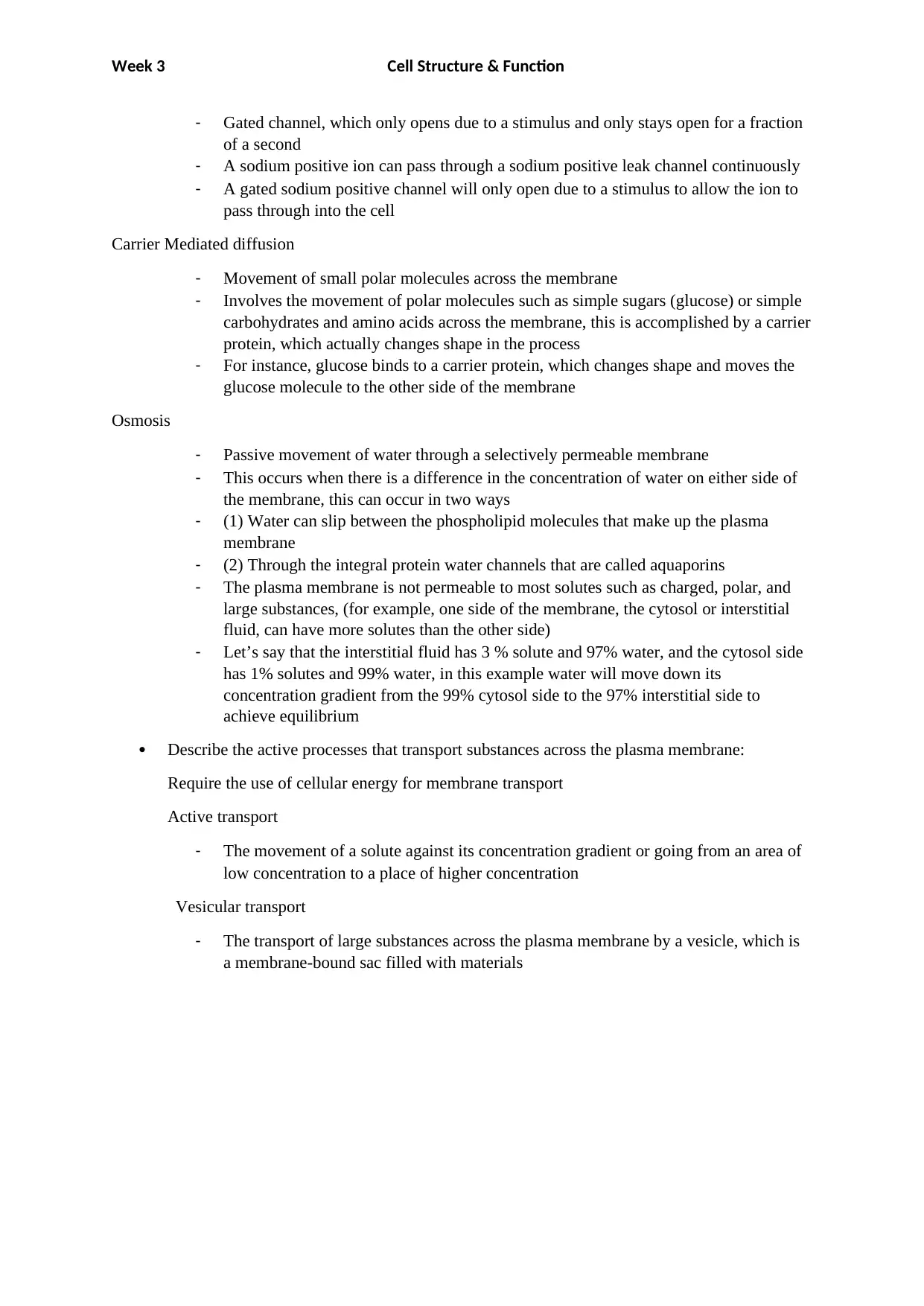
Week 3 Cell Structure & Function
- Gated channel, which only opens due to a stimulus and only stays open for a fraction
of a second
- A sodium positive ion can pass through a sodium positive leak channel continuously
- A gated sodium positive channel will only open due to a stimulus to allow the ion to
pass through into the cell
Carrier Mediated diffusion
- Movement of small polar molecules across the membrane
- Involves the movement of polar molecules such as simple sugars (glucose) or simple
carbohydrates and amino acids across the membrane, this is accomplished by a carrier
protein, which actually changes shape in the process
- For instance, glucose binds to a carrier protein, which changes shape and moves the
glucose molecule to the other side of the membrane
Osmosis
- Passive movement of water through a selectively permeable membrane
- This occurs when there is a difference in the concentration of water on either side of
the membrane, this can occur in two ways
- (1) Water can slip between the phospholipid molecules that make up the plasma
membrane
- (2) Through the integral protein water channels that are called aquaporins
- The plasma membrane is not permeable to most solutes such as charged, polar, and
large substances, (for example, one side of the membrane, the cytosol or interstitial
fluid, can have more solutes than the other side)
- Let’s say that the interstitial fluid has 3 % solute and 97% water, and the cytosol side
has 1% solutes and 99% water, in this example water will move down its
concentration gradient from the 99% cytosol side to the 97% interstitial side to
achieve equilibrium
Describe the active processes that transport substances across the plasma membrane:
Require the use of cellular energy for membrane transport
Active transport
- The movement of a solute against its concentration gradient or going from an area of
low concentration to a place of higher concentration
Vesicular transport
- The transport of large substances across the plasma membrane by a vesicle, which is
a membrane-bound sac filled with materials
- Gated channel, which only opens due to a stimulus and only stays open for a fraction
of a second
- A sodium positive ion can pass through a sodium positive leak channel continuously
- A gated sodium positive channel will only open due to a stimulus to allow the ion to
pass through into the cell
Carrier Mediated diffusion
- Movement of small polar molecules across the membrane
- Involves the movement of polar molecules such as simple sugars (glucose) or simple
carbohydrates and amino acids across the membrane, this is accomplished by a carrier
protein, which actually changes shape in the process
- For instance, glucose binds to a carrier protein, which changes shape and moves the
glucose molecule to the other side of the membrane
Osmosis
- Passive movement of water through a selectively permeable membrane
- This occurs when there is a difference in the concentration of water on either side of
the membrane, this can occur in two ways
- (1) Water can slip between the phospholipid molecules that make up the plasma
membrane
- (2) Through the integral protein water channels that are called aquaporins
- The plasma membrane is not permeable to most solutes such as charged, polar, and
large substances, (for example, one side of the membrane, the cytosol or interstitial
fluid, can have more solutes than the other side)
- Let’s say that the interstitial fluid has 3 % solute and 97% water, and the cytosol side
has 1% solutes and 99% water, in this example water will move down its
concentration gradient from the 99% cytosol side to the 97% interstitial side to
achieve equilibrium
Describe the active processes that transport substances across the plasma membrane:
Require the use of cellular energy for membrane transport
Active transport
- The movement of a solute against its concentration gradient or going from an area of
low concentration to a place of higher concentration
Vesicular transport
- The transport of large substances across the plasma membrane by a vesicle, which is
a membrane-bound sac filled with materials
⊘ This is a preview!⊘
Do you want full access?
Subscribe today to unlock all pages.

Trusted by 1+ million students worldwide
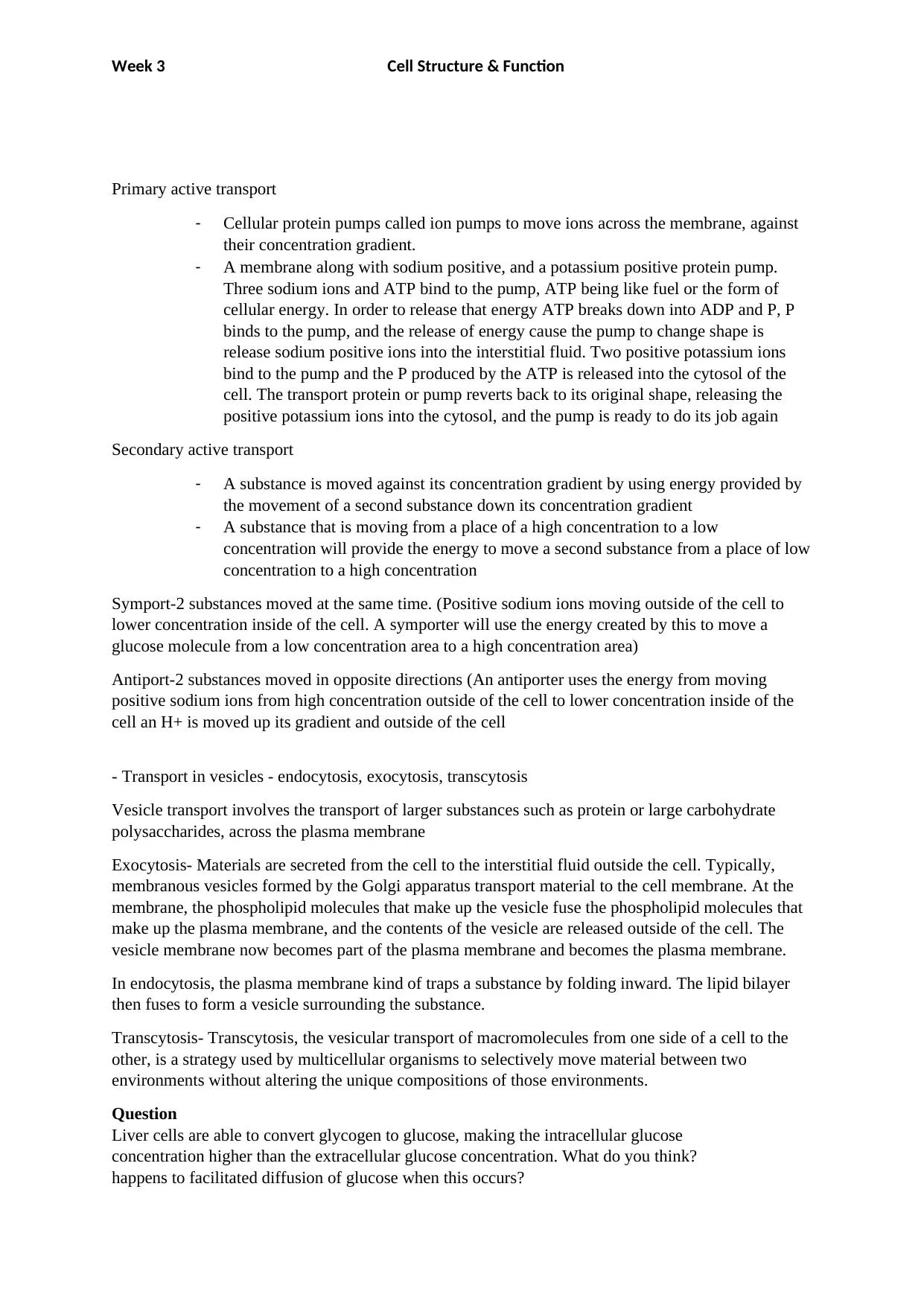
Week 3 Cell Structure & Function
Primary active transport
- Cellular protein pumps called ion pumps to move ions across the membrane, against
their concentration gradient.
- A membrane along with sodium positive, and a potassium positive protein pump.
Three sodium ions and ATP bind to the pump, ATP being like fuel or the form of
cellular energy. In order to release that energy ATP breaks down into ADP and P, P
binds to the pump, and the release of energy cause the pump to change shape is
release sodium positive ions into the interstitial fluid. Two positive potassium ions
bind to the pump and the P produced by the ATP is released into the cytosol of the
cell. The transport protein or pump reverts back to its original shape, releasing the
positive potassium ions into the cytosol, and the pump is ready to do its job again
Secondary active transport
- A substance is moved against its concentration gradient by using energy provided by
the movement of a second substance down its concentration gradient
- A substance that is moving from a place of a high concentration to a low
concentration will provide the energy to move a second substance from a place of low
concentration to a high concentration
Symport-2 substances moved at the same time. (Positive sodium ions moving outside of the cell to
lower concentration inside of the cell. A symporter will use the energy created by this to move a
glucose molecule from a low concentration area to a high concentration area)
Antiport-2 substances moved in opposite directions (An antiporter uses the energy from moving
positive sodium ions from high concentration outside of the cell to lower concentration inside of the
cell an H+ is moved up its gradient and outside of the cell
- Transport in vesicles - endocytosis, exocytosis, transcytosis
Vesicle transport involves the transport of larger substances such as protein or large carbohydrate
polysaccharides, across the plasma membrane
Exocytosis- Materials are secreted from the cell to the interstitial fluid outside the cell. Typically,
membranous vesicles formed by the Golgi apparatus transport material to the cell membrane. At the
membrane, the phospholipid molecules that make up the vesicle fuse the phospholipid molecules that
make up the plasma membrane, and the contents of the vesicle are released outside of the cell. The
vesicle membrane now becomes part of the plasma membrane and becomes the plasma membrane.
In endocytosis, the plasma membrane kind of traps a substance by folding inward. The lipid bilayer
then fuses to form a vesicle surrounding the substance.
Transcytosis- Transcytosis, the vesicular transport of macromolecules from one side of a cell to the
other, is a strategy used by multicellular organisms to selectively move material between two
environments without altering the unique compositions of those environments.
Question
Liver cells are able to convert glycogen to glucose, making the intracellular glucose
concentration higher than the extracellular glucose concentration. What do you think?
happens to facilitated diffusion of glucose when this occurs?
Primary active transport
- Cellular protein pumps called ion pumps to move ions across the membrane, against
their concentration gradient.
- A membrane along with sodium positive, and a potassium positive protein pump.
Three sodium ions and ATP bind to the pump, ATP being like fuel or the form of
cellular energy. In order to release that energy ATP breaks down into ADP and P, P
binds to the pump, and the release of energy cause the pump to change shape is
release sodium positive ions into the interstitial fluid. Two positive potassium ions
bind to the pump and the P produced by the ATP is released into the cytosol of the
cell. The transport protein or pump reverts back to its original shape, releasing the
positive potassium ions into the cytosol, and the pump is ready to do its job again
Secondary active transport
- A substance is moved against its concentration gradient by using energy provided by
the movement of a second substance down its concentration gradient
- A substance that is moving from a place of a high concentration to a low
concentration will provide the energy to move a second substance from a place of low
concentration to a high concentration
Symport-2 substances moved at the same time. (Positive sodium ions moving outside of the cell to
lower concentration inside of the cell. A symporter will use the energy created by this to move a
glucose molecule from a low concentration area to a high concentration area)
Antiport-2 substances moved in opposite directions (An antiporter uses the energy from moving
positive sodium ions from high concentration outside of the cell to lower concentration inside of the
cell an H+ is moved up its gradient and outside of the cell
- Transport in vesicles - endocytosis, exocytosis, transcytosis
Vesicle transport involves the transport of larger substances such as protein or large carbohydrate
polysaccharides, across the plasma membrane
Exocytosis- Materials are secreted from the cell to the interstitial fluid outside the cell. Typically,
membranous vesicles formed by the Golgi apparatus transport material to the cell membrane. At the
membrane, the phospholipid molecules that make up the vesicle fuse the phospholipid molecules that
make up the plasma membrane, and the contents of the vesicle are released outside of the cell. The
vesicle membrane now becomes part of the plasma membrane and becomes the plasma membrane.
In endocytosis, the plasma membrane kind of traps a substance by folding inward. The lipid bilayer
then fuses to form a vesicle surrounding the substance.
Transcytosis- Transcytosis, the vesicular transport of macromolecules from one side of a cell to the
other, is a strategy used by multicellular organisms to selectively move material between two
environments without altering the unique compositions of those environments.
Question
Liver cells are able to convert glycogen to glucose, making the intracellular glucose
concentration higher than the extracellular glucose concentration. What do you think?
happens to facilitated diffusion of glucose when this occurs?
Paraphrase This Document
Need a fresh take? Get an instant paraphrase of this document with our AI Paraphraser
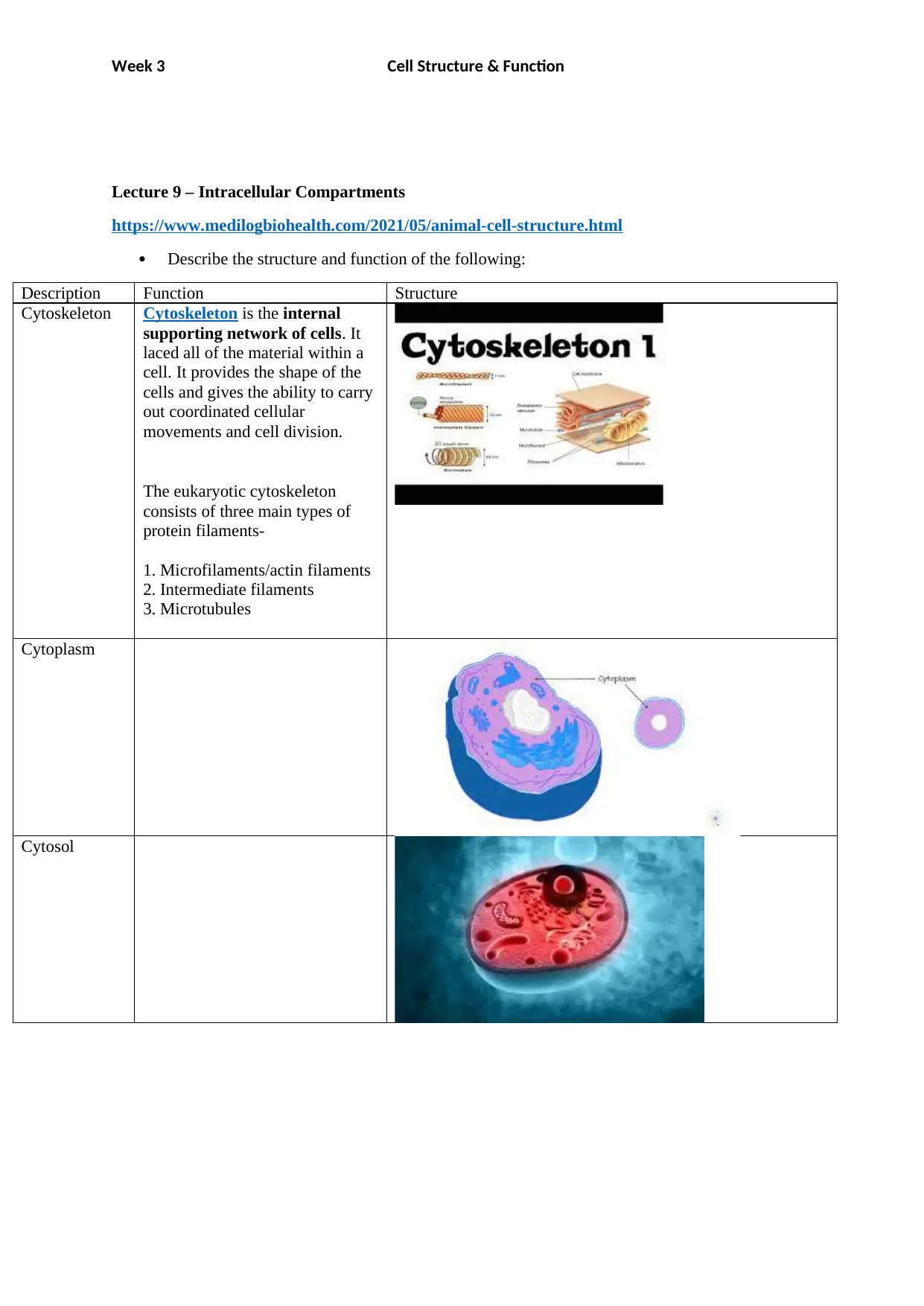
Week 3 Cell Structure & Function
Lecture 9 – Intracellular Compartments
https://www.medilogbiohealth.com/2021/05/animal-cell-structure.html
Describe the structure and function of the following:
Description Function Structure
Cytoskeleton Cytoskeleton is the internal
supporting network of cells. It
laced all of the material within a
cell. It provides the shape of the
cells and gives the ability to carry
out coordinated cellular
movements and cell division.
The eukaryotic cytoskeleton
consists of three main types of
protein filaments-
1. Microfilaments/actin filaments
2. Intermediate filaments
3. Microtubules
Cytoplasm
Cytosol
Lecture 9 – Intracellular Compartments
https://www.medilogbiohealth.com/2021/05/animal-cell-structure.html
Describe the structure and function of the following:
Description Function Structure
Cytoskeleton Cytoskeleton is the internal
supporting network of cells. It
laced all of the material within a
cell. It provides the shape of the
cells and gives the ability to carry
out coordinated cellular
movements and cell division.
The eukaryotic cytoskeleton
consists of three main types of
protein filaments-
1. Microfilaments/actin filaments
2. Intermediate filaments
3. Microtubules
Cytoplasm
Cytosol
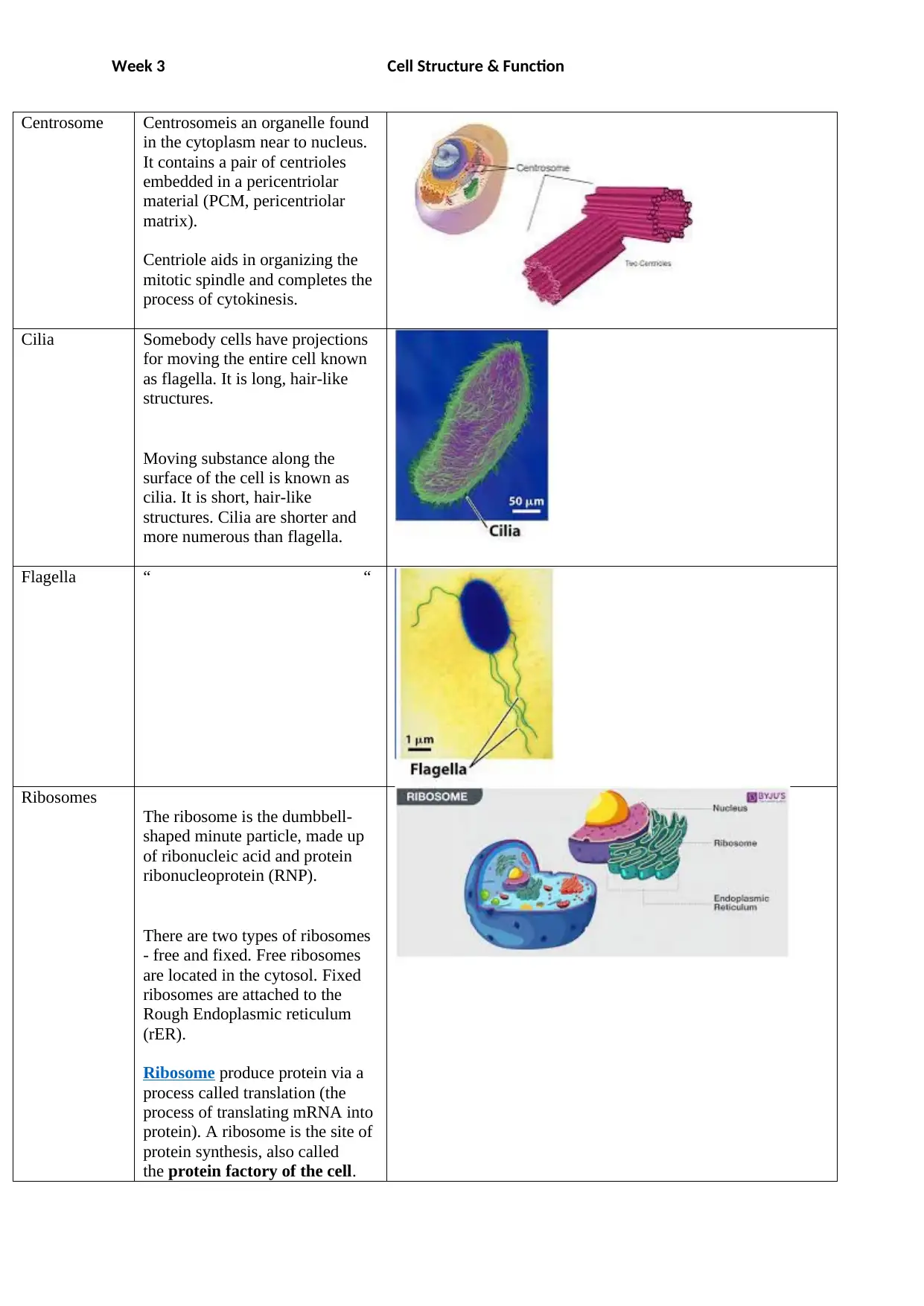
Week 3 Cell Structure & Function
Centrosome Centrosomeis an organelle found
in the cytoplasm near to nucleus.
It contains a pair of centrioles
embedded in a pericentriolar
material (PCM, pericentriolar
matrix).
Centriole aids in organizing the
mitotic spindle and completes the
process of cytokinesis.
Cilia Somebody cells have projections
for moving the entire cell known
as flagella. It is long, hair-like
structures.
Moving substance along the
surface of the cell is known as
cilia. It is short, hair-like
structures. Cilia are shorter and
more numerous than flagella.
Flagella “ “
Ribosomes
The ribosome is the dumbbell-
shaped minute particle, made up
of ribonucleic acid and protein
ribonucleoprotein (RNP).
There are two types of ribosomes
- free and fixed. Free ribosomes
are located in the cytosol. Fixed
ribosomes are attached to the
Rough Endoplasmic reticulum
(rER).
Ribosome produce protein via a
process called translation (the
process of translating mRNA into
protein). A ribosome is the site of
protein synthesis, also called
the protein factory of the cell.
Centrosome Centrosomeis an organelle found
in the cytoplasm near to nucleus.
It contains a pair of centrioles
embedded in a pericentriolar
material (PCM, pericentriolar
matrix).
Centriole aids in organizing the
mitotic spindle and completes the
process of cytokinesis.
Cilia Somebody cells have projections
for moving the entire cell known
as flagella. It is long, hair-like
structures.
Moving substance along the
surface of the cell is known as
cilia. It is short, hair-like
structures. Cilia are shorter and
more numerous than flagella.
Flagella “ “
Ribosomes
The ribosome is the dumbbell-
shaped minute particle, made up
of ribonucleic acid and protein
ribonucleoprotein (RNP).
There are two types of ribosomes
- free and fixed. Free ribosomes
are located in the cytosol. Fixed
ribosomes are attached to the
Rough Endoplasmic reticulum
(rER).
Ribosome produce protein via a
process called translation (the
process of translating mRNA into
protein). A ribosome is the site of
protein synthesis, also called
the protein factory of the cell.
⊘ This is a preview!⊘
Do you want full access?
Subscribe today to unlock all pages.

Trusted by 1+ million students worldwide
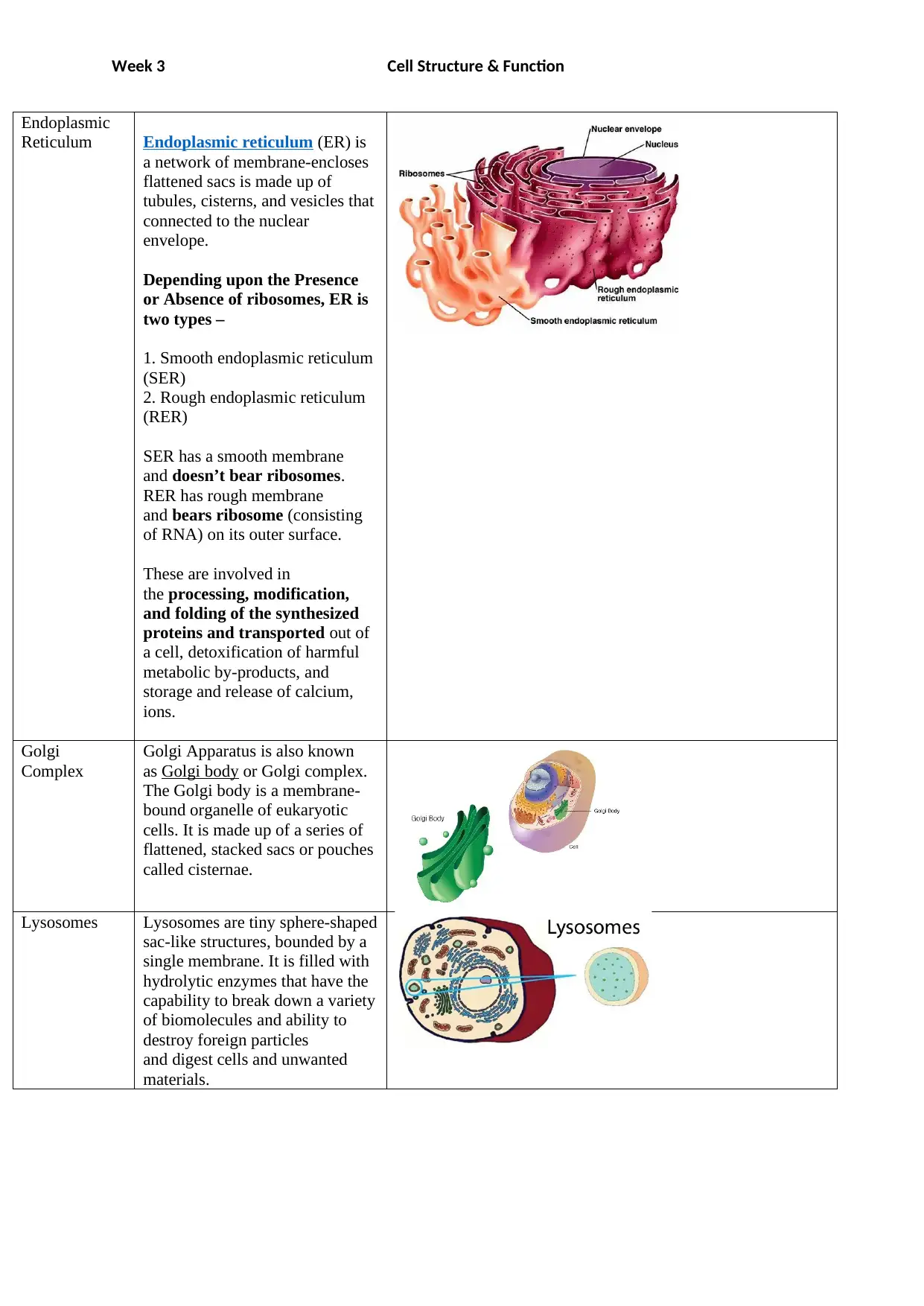
Week 3 Cell Structure & Function
Endoplasmic
Reticulum Endoplasmic reticulum (ER) is
a network of membrane-encloses
flattened sacs is made up of
tubules, cisterns, and vesicles that
connected to the nuclear
envelope.
Depending upon the Presence
or Absence of ribosomes, ER is
two types –
1. Smooth endoplasmic reticulum
(SER)
2. Rough endoplasmic reticulum
(RER)
SER has a smooth membrane
and doesn’t bear ribosomes.
RER has rough membrane
and bears ribosome (consisting
of RNA) on its outer surface.
These are involved in
the processing, modification,
and folding of the synthesized
proteins and transported out of
a cell, detoxification of harmful
metabolic by-products, and
storage and release of calcium,
ions.
Golgi
Complex
Golgi Apparatus is also known
as Golgi body or Golgi complex.
The Golgi body is a membrane-
bound organelle of eukaryotic
cells. It is made up of a series of
flattened, stacked sacs or pouches
called cisternae.
Lysosomes Lysosomes are tiny sphere-shaped
sac-like structures, bounded by a
single membrane. It is filled with
hydrolytic enzymes that have the
capability to break down a variety
of biomolecules and ability to
destroy foreign particles
and digest cells and unwanted
materials.
Endoplasmic
Reticulum Endoplasmic reticulum (ER) is
a network of membrane-encloses
flattened sacs is made up of
tubules, cisterns, and vesicles that
connected to the nuclear
envelope.
Depending upon the Presence
or Absence of ribosomes, ER is
two types –
1. Smooth endoplasmic reticulum
(SER)
2. Rough endoplasmic reticulum
(RER)
SER has a smooth membrane
and doesn’t bear ribosomes.
RER has rough membrane
and bears ribosome (consisting
of RNA) on its outer surface.
These are involved in
the processing, modification,
and folding of the synthesized
proteins and transported out of
a cell, detoxification of harmful
metabolic by-products, and
storage and release of calcium,
ions.
Golgi
Complex
Golgi Apparatus is also known
as Golgi body or Golgi complex.
The Golgi body is a membrane-
bound organelle of eukaryotic
cells. It is made up of a series of
flattened, stacked sacs or pouches
called cisternae.
Lysosomes Lysosomes are tiny sphere-shaped
sac-like structures, bounded by a
single membrane. It is filled with
hydrolytic enzymes that have the
capability to break down a variety
of biomolecules and ability to
destroy foreign particles
and digest cells and unwanted
materials.
Paraphrase This Document
Need a fresh take? Get an instant paraphrase of this document with our AI Paraphraser
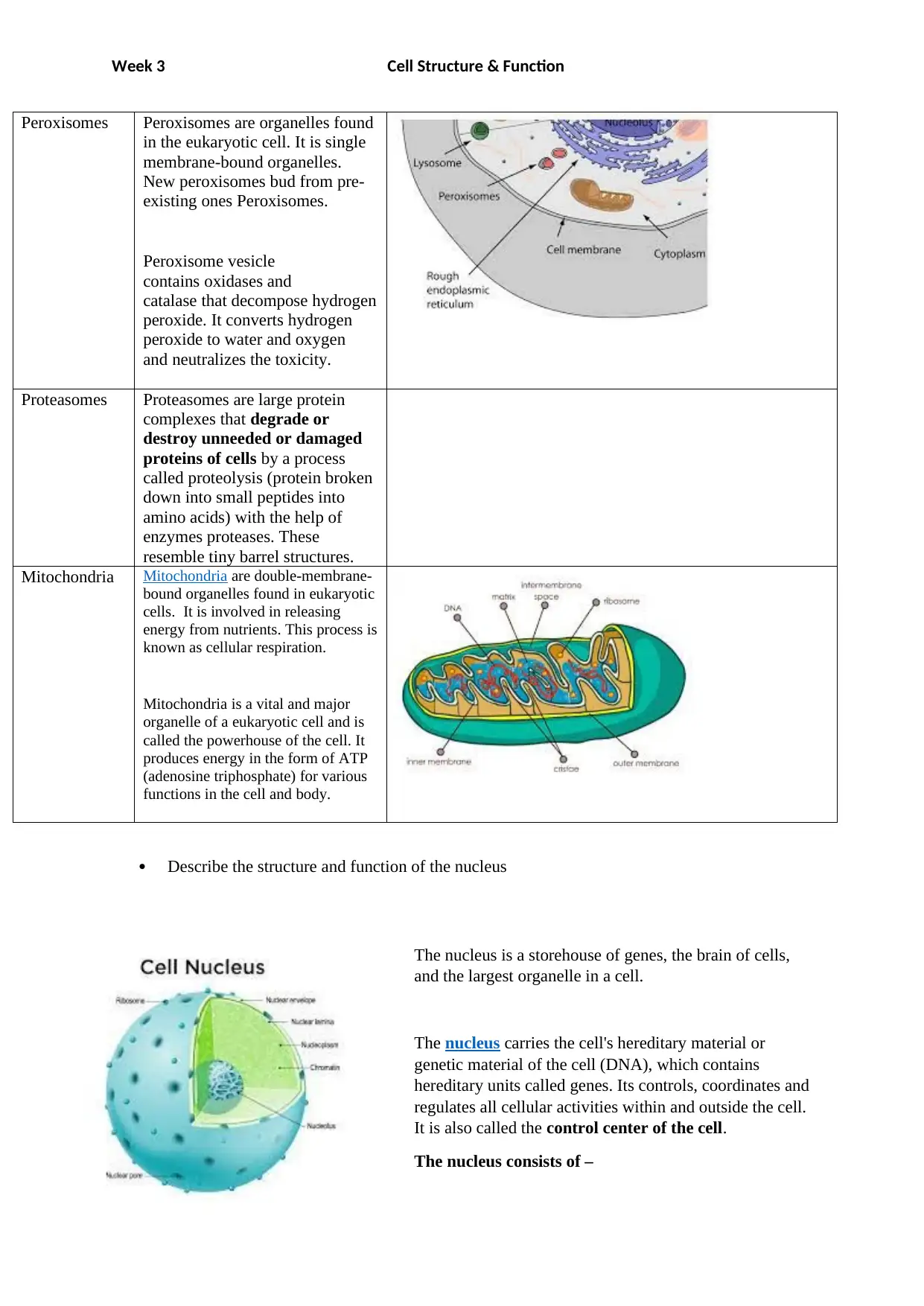
Week 3 Cell Structure & Function
Peroxisomes Peroxisomes are organelles found
in the eukaryotic cell. It is single
membrane-bound organelles.
New peroxisomes bud from pre-
existing ones Peroxisomes.
Peroxisome vesicle
contains oxidases and
catalase that decompose hydrogen
peroxide. It converts hydrogen
peroxide to water and oxygen
and neutralizes the toxicity.
Proteasomes Proteasomes are large protein
complexes that degrade or
destroy unneeded or damaged
proteins of cells by a process
called proteolysis (protein broken
down into small peptides into
amino acids) with the help of
enzymes proteases. These
resemble tiny barrel structures.
Mitochondria Mitochondria are double-membrane-
bound organelles found in eukaryotic
cells. It is involved in releasing
energy from nutrients. This process is
known as cellular respiration.
Mitochondria is a vital and major
organelle of a eukaryotic cell and is
called the powerhouse of the cell. It
produces energy in the form of ATP
(adenosine triphosphate) for various
functions in the cell and body.
Describe the structure and function of the nucleus
The nucleus is a storehouse of genes, the brain of cells,
and the largest organelle in a cell.
The nucleus carries the cell's hereditary material or
genetic material of the cell (DNA), which contains
hereditary units called genes. Its controls, coordinates and
regulates all cellular activities within and outside the cell.
It is also called the control center of the cell.
The nucleus consists of –
Peroxisomes Peroxisomes are organelles found
in the eukaryotic cell. It is single
membrane-bound organelles.
New peroxisomes bud from pre-
existing ones Peroxisomes.
Peroxisome vesicle
contains oxidases and
catalase that decompose hydrogen
peroxide. It converts hydrogen
peroxide to water and oxygen
and neutralizes the toxicity.
Proteasomes Proteasomes are large protein
complexes that degrade or
destroy unneeded or damaged
proteins of cells by a process
called proteolysis (protein broken
down into small peptides into
amino acids) with the help of
enzymes proteases. These
resemble tiny barrel structures.
Mitochondria Mitochondria are double-membrane-
bound organelles found in eukaryotic
cells. It is involved in releasing
energy from nutrients. This process is
known as cellular respiration.
Mitochondria is a vital and major
organelle of a eukaryotic cell and is
called the powerhouse of the cell. It
produces energy in the form of ATP
(adenosine triphosphate) for various
functions in the cell and body.
Describe the structure and function of the nucleus
The nucleus is a storehouse of genes, the brain of cells,
and the largest organelle in a cell.
The nucleus carries the cell's hereditary material or
genetic material of the cell (DNA), which contains
hereditary units called genes. Its controls, coordinates and
regulates all cellular activities within and outside the cell.
It is also called the control center of the cell.
The nucleus consists of –

Week 3 Cell Structure & Function
1. Nucleoplasm
2. Nucleolus
3. Nuclear Pore
4. Nuclear Envelope/ Nuclear Membrane
1. Nucleoplasm
2. Nucleolus
3. Nuclear Pore
4. Nuclear Envelope/ Nuclear Membrane
⊘ This is a preview!⊘
Do you want full access?
Subscribe today to unlock all pages.

Trusted by 1+ million students worldwide
1 out of 9
Related Documents
Your All-in-One AI-Powered Toolkit for Academic Success.
+13062052269
info@desklib.com
Available 24*7 on WhatsApp / Email
![[object Object]](/_next/static/media/star-bottom.7253800d.svg)
Unlock your academic potential
Copyright © 2020–2025 A2Z Services. All Rights Reserved. Developed and managed by ZUCOL.





